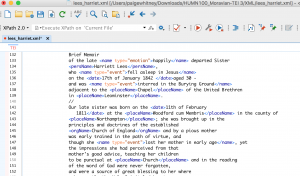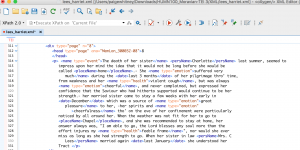Link to our Website: http://leeshumn100.blogs.bucknell.edu
I have come to realize as I reflect on the past semester that Humanities 100 was my favorite class this semester. I am surprisingly impressed with how much I have learned in such a short amount of time. I signed up for it because it sounded interesting and fulfilled one of my CCC requirements. I did not know what to expect and was slightly nervous after hearing about it the first day of class. Although there were times that were challenging and frustrating, I overall loved how interactive class was and am extremely proud of all the hard work I have put in throughout the semester.
One major skill this class has taught me is how to read for important information quickly and effectively, which was beneficial because I have always been considered a slow reader. I was flustered when I was given the memoir of Harriet Lees that is hundreds of years old because I did not know what to search for when analyzing. It was at this point in the class where I learned the importance of transcriptions. Again, I was a little confused at first, but it became easier and easier as I started completing each assignment. Transcriptions are a way of analyzing a text in a great amount of depth to seek out the maximum amount of important information.
 ]
] .
.  .
. 
Working with Hailey Zimmerman on the memoir of Harriet Lees was extremely fun. The memoir is short, just about twelve pages, which I also enjoyed because we got to read and reread it as many times needed to understand her life story. When transcribing the original document, we split the pages up amongst us: six pages for me, six pages for Hailey. This process was my favorite part of the semester. Hailey and I would sit side by side making out the words and sentences that were written in cursive. We would ask one another when we couldn’t make out a word or phrase, which happened quite often. It was funny to see how some words I could easily read were so difficult for her and vice versa. Although this process was fun, it was very difficult at times due to the unfamiliar handwriting (cursive), sayings, and places in England. It was also difficult because some letters looked so similar to each other, so to resolve this issue we looked back at previous words with the same letter(s) and compared them. It was very critical that our transcription of the memoir was correct and made sense because it is used for every project for the rest of the semester. With that in mind, Hailey and I read through our transcriptions three times and thankfully we did because we found some mistakes. Voyant was the next step in our project. Again, this was a novel tool for both Hailey. Voyant was extremely helpful because it offered us the opportunity to learn about Harriet Lees’ life in new ways and in more depth. Voyant consisted of charts, lists, graphs that highlighted the most frequent words and phrases in our text, which made it easy to see what was of importance. It offered us a way to look deeply into the text and observe what hardships Harriet Lees faced and how she overcame them. Voyant is an efficient and more pleasing way to gain the important information needed from a long text. My favorite tool in voyant I used was cirrus. The next project Hailey and I did was the timeline and story map of Harriet Lees’ life, which was also very interesting and fun. The timeline helped arrange Harriet Lees’ life in a systematic order; which we used three major dates: her birth, marriage, and death. The timeline allowed us to make connections in her life to the world around her in that time. Specifically, we were able to gain a better understanding of Harriet Lees’ suffering and death from tuberculosis. We incorporated pictures to help the viewer envision the information we discussed. The story map was an extremely cool tool to work with, but again I did run into some struggles. The story map we created showed specific places in England where Harriet Lees’ lived, died, and traveled to. A struggle I was referring to earlier was that the memoir did not provide us with enough pages to make a strong story map, but after further research, we chose other relevant places in England that connected to Harriet Lees’ life. For example, we used London as a place and then compared and contrasted the different lifestyles in the nineteenth century. The story map provides a way for one to track the Harriet Lees’ life in a fun and information way. The Google Fusion table was another project we completed this semester. We took words from the memoir and put them into a spreadsheet that allowed us to indicate the important relationships. Hailey and I found that the strongest relationship in the memoir of Harriet Lees was emotion to health, which made sense because the majority of the memoir discussed Harriet Lees suffering from an inflammation in her lungs.
Another important aspect to Humanities 100 that broadened my understanding of the projects and the materials was the homework readings. It was cool to see the correlations between the readings and the projects when writing the blog posts. One of my favorite readings this semester is Grafton’s “Cartographies of Time”. I really enjoyed the timeline project and this reading gave me more insight on the importance dates and how beneficial of timelines can be. Another reading in specific that I really enjoyed was Bodenhamers, “The Spatial Humanities”. I really enjoyed this article because I think the author had a lot of good points that were relevant in my project. My favorite point he made was, “we see space as the platform for multiplicity, a realm where all perspectives are particular and dependent upon experiences unique to an individual, a community, or a period of time” (Bodenhamer 14).
The website Hailey and I created for our final project was extremely rewarding to finish. Our homepage is simple and has a lot of tabs that connect one to more information on the memoir of Harriet Lees. Each tab links one to information on a specific topic. Some of the information we included was the Moravian Church, Moravian Women, Geographical Context, Gender History, and more. Along with the information aspect, we included pictures and links to our past projects. Each tab is unique and provides insight on life in the nineteenth century, specifically Harriet Lees’. It is important to note that although Harriet Lees is one women, her life is extremely important for many reasons, which is explained in the website under the “Research Question” tab. Overall, this website incorporates and combines all the different information and components we have encountered this semester, which will be very helpful for people doing further research.
 .
. 
Again, thank you so much for this semester and I appreciate all the work you, Professor Faull, Carry, and Courtney have done to help me learn. I will forever remember this class and hope to use some of the skills I learned in the future. Merry Christmas and Happy New Year!
http://www2.ivcc.edu/gen2002/women_in_the_nineteenth_century.htm
http://www.localhistories.org/vicwomen.html
Paige Whitney is a sophomore at Bucknell University. She is from Darien, CT. She is undeclared, but has interests in psychology, management, and economics.



